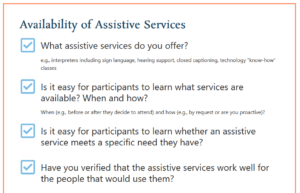Checklist: Barriers to Artistic Engagement

Seniors Art Link
Is your arts program putting up barriers or breaking them down for older adults?
We interviewed 33 older adults on a range of issues relating to art and technology, including what they found prevented them from accessing more arts programming. The full results are included in the research report.
To help turn knowledge into action, we’ve created this checklist based on what they said. This is not an exhaustive list, but it’s intended to help you and your team think about ways that older adults can feel included (or excluded) in how you develop, advertise, and run your arts and cultural programs.
“Barriers are experienced differently by different people; what works to resolve access issues for one person may creates access issues for others.” SM AIS Research Report
Availability of Assistive Services
What assistive services do you offer?
e.g., interpreters including sign language, hearing support, closed captioning, technology “know-how” classes
Is it easy for participants to learn what services are available? When and how?
When (e.g., before or after they decide to attend) and how (e.g., by request or are you proactive)?
Is it easy for participants to learn whether an assistive service meets a specific need they have?
Have you verified that the assistive services work well for the people that would use them?
Program-centered Barriers
Is the program very long? Are there breaks?
How will the program be experienced by older adults with concerns about their energy level, attention span, physical health, and chronic health conditions?
Is the pace of the program or instruction appropriate?
Some ways of presenting programs online can exclude people who need a slower pace or different kinds of instruction.
Is the program at a time of day that is convenient for older adults?
Is clear and complete information about the program easily available?
Is the program accessible to people from rural areas?
For online programs, is internet speed an issue that has been considered? For in-person programs, is location or transportation an issue for some potential participants?
Technology as a Barrier
Is there a high technology cost to participate?
Will participants with older or slower devices be at a disadvantage?
Is there a lot of equipment or technical processes to learn about in order to participate?
Is the technology of an online program able to "communicate" art well?
e.g., a participant joining a watercolour program online may have difficulty showing the artwork if their camera is stationary and the work can't be moved into frame.
What kind of technical support is provided to participants?
Can support be provided, before or during an event? Will the event have to pause for everyone if one participant is having technical difficulty?
Financial Barriers
Is the cost to participate high?
Is there an equipment or a materials cost?
Can you provide materials, or mail kits out ahead of time?
Language as a Barrier
Are people who do not use English as their primary language able to participate?
Other Barriers
Have you considered what is required to make a participant feel eligible and confident enough to take part?
How can the words, images, and themes used to promote a program, and the facilitation during and following a program, contribute to older adults feeling like they don't belong there?
This checklist was adapted from the Direct[message] Administered Interactive Survey Research Report